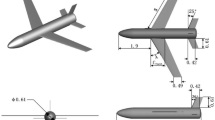Abstract
In this paper, the multi-objective, multifidelity optimization of a wing fence on an unmanned aerial vehicle (UAV) near stall is presented. The UAV under consideration is characterized by a blended wing body (BWB), which increases its efficiency, and a tailless design, which leads to a swept wing to ensure longitudinal static stability. The consequence is a possible appearance of a nose-up moment, loss of lift initiating at the tips, and reduced controllability during landing, commonly referred to as tip stall. A possible solution to counter this phenomenon is wing fences: planes placed on top of the wing aligned with the flow and developed from the idea of stopping the transverse component of the boundary layer flow. These are optimized to obtain the design that would fence off the appearance of a pitch-up moment at high angles of attack, without a significant loss of lift and controllability. This brings forth a constrained multi-objective optimization problem. The evaluations are performed through unsteady Reynolds-Averaged Navier–Stokes (URANS) simulations. However, since controllability cannot be directly assessed through computational fluid dynamics (CFD), surrogate-derived gradients are used. An efficient global optimization framework is developed employing surrogate modeling, namely regressive co-Kriging, updated using a multi-objective formulation of the expected improvement. The result is a wing fence design that extends the flight envelope of the aircraft, obtained with a feasible computational budget.





Similar content being viewed by others
Notes
The longitudinal moment is addressed as the pitching moment and defined as the total moment around the tranverse/lateral axis, perpendicular to the symmetry plane with its origin in the center of gravity. For equilibrium flight, this moment must equal zero. In this regard, the pitching moment coefficient of the UAV differs from the conventional pitching moment of an airfoil, which is defined around its aerodynamic center.
We assume at this point that the variations in Re during the optimization are small enough to be negligible
The constrained expected improvement is divided by the Euclidean distance of the two points farthest from each other in de objective space.
The Pareto front is the front defined in the objective space by the Pareto optimal points for which one cannot improve on one without deteriorating on the others.
The hypervolume is the Lebesgue measure contained by the attainment surface and a chosen reference points. The attainment surface was defined by Fonseca and Fleming (1996) as “the boundary in the objective space separating those points which are dominated by or equal to at least one of the data points, from those which no data points dominates or equals” and thus corresponds to the Pareto front.
The Pareto fronts are rescaled to a 1-on-1 box. This is done such that the influence of both objectives on the hypervolume is nearly equally significant.
References
Bevan RLT, Poole DJ, Allen CB, Rendall TCS (2017) Adaptive surrogate-based optimization of vortex generators for tiltrotor geometry. J Aircr 54(3):1011–1024. https://doi.org/10.2514/1.C033838
Couckuyt I, Deschrijver D, Dhaene T (2014) Fast calculation of multiobjective probability of improvement and expected improvement criteria for Pareto optimization. J Glob Optim 60(3):575–594. https://doi.org/10.1007/s10898-013-0118-2
Couckuyt I, Dhaene T (2014) Demeester, p.: ooDACE toolbox: a flexible object-oriented Kriging implementation. J Mach Learn Res 15(1):3183–3186
Dhamotharan V, Jadhav PD, Ramu P, Prakash AK (2018) Optimal design of savonius wind turbines using ensemble of surrogates and CFD analysis. Struct Multidiscip Optim 58 (6):2711–2726. https://doi.org/10.1007/s00158-018-2052-x
Fonseca CM, Fleming PJ (1996) On the performance assessment and comparison of stochastic multiobjective optimizers. In: Voigt Hm, Ebeling W, Rechenberg I, Schwefel HP (eds) Parallel Problem Solving from Nature — PPSN IV. Springer, Berlin, pp 584–593
Forrester A, Sóbester A, Keane A (2006) Optimization with missing data. Proceedings of the Royal Society a: Mathematical, Physical and Engineering Science 462(2067):935. https://doi.org/10.1098/rspa.2005.1608
Forrester A, Sóbester A, Keane A (2007) Multi-fidelity optimization via surrogate modelling. Proceedings of the Royal Society a-Mathematical Physical and Engineering Sciences 463(2088):3251–3269. https://doi.org/10.1098/rspa.2007.1900
Forrester A, Sóbester A, Keane A (2008) Engineering design via surrogate modelling: a practical guide. Wiley, Hoboken
Haines AB (1980) Aerodynamic interference. AGARD special course on Subsonic/Transonic aerodynamic interference for aircraft
Han ZH, Görtz S, Zimmermann R (2013) Improving variable-fidelity surrogate modeling via gradient-enhanced kriging and a generalized hybrid bridge function. Aerosp Sci Technol 25(1):177–189. https://doi.org/10.1016/j.ast.2012.01.006
Han ZH, Zhang Y, Song CX, Zhang KS (2017) Weighted gradient-enhanced kriging for high-dimensional surrogate modeling and design optimization. AIAA J 55(12):4330–4346. https://doi.org/10.2514/1.J055842
Jeong S, Obayashi S (2005) Efficient global optimization (EGO) for multi-objective problem and data mining. In: 2005 IEEE Congress on Evolutionary Computation, vol 3, pp 2138–2145
Jones DR, Schonlau M, Welch WJ (1998) Efficient global optimization of expensive black-box functions. J Glob Optim 13(4):455–492. https://doi.org/10.1023/A:1008306431147
Keane AJ (2006) Statistical improvement criteria for use in multiobjective design optimization. AIAA J 44 (4):879–891. https://doi.org/10.2514/1.16875
Kennedy MC, O’Hagan A (2000) Predicting the output from a complex computer code when fast approximations are available. Biometrika 87(1):1–13. https://doi.org/10.1093/biomet/87.1.1
Kenway GKW, Martins JRRA (2015) Multipoint aerodynamic shape optimization investigations of the common research model wing. AIAA J 54(1):113–128. https://doi.org/10.2514/1.J054154
Knowles J (2005) ParEGO: a hybrid algorithm with on-line landscape approximation for expensive multiobjective optimization problems. IEEE Trans Evol Comput 10(1):50–66. https://doi.org/10.1109/TEVC.2005.851274
Lissaman PBS (1983) Low-Reynolds-number airfoils. Ann Rev Fluid Mech 15(1):223–239. https://doi.org/10.1146/annurev.fl.15.010183.001255
Loeppky JL, Sacks J, Welch WJ (2009) Choosing the sample size of a computer experiment: a practical guide. Technometrics 51(4):366–376. https://doi.org/10.1198/TECH.2009.08040
Marrel A, Iooss B, Laurent B, Roustant O (2009) Calculations of sobol indices for the Gaussian process metamodel. Reliab Eng Syst Saf 94(3):742–751. https://doi.org/10.1016/jress200807008
McKay MD, Beckman RJ, Conover WJ (1979) A comparison of three methods for selecting values of input variables in the analysis of output from a computer code. Technometrics 21(2):239–245. https://doi.org/10.2307/1268522
Menter FR, Langtry RB, Likki SR, Suzen YB, Huang PG, Volker S (2006) A correlation-based transition model using local variables - part i: Model formulation. Journal of Turbomachinery-Transactions of the Asme 128(3):413–422. https://doi.org/10.1115/1.2184352
Morris MD, Mitchell TJ (1995) Exploratory designs for computational experiments. Journal of Statistical Planning and Inference 43(3):381–402. https://doi.org/10.1016/0378-3758(94)00035-T
Namura N, Obayashi S, Jeong S (2016) Efficient global optimization of vortex generators on a supercritical infinite wing. J Aircr 53(6):1670–1679. https://doi.org/10.2514/1.C033753
Nickel K, Wohlfahrt M (1994) Tailless aircraft in theory and practice. American Institute of Aeronautics and Astronautics, Washington
Okonkwo P, Smith H (2016) Review of evolving trends in blended wing body aircraft design. Prog Aerosp Sci 82:1–23. https://doi.org/10.1016/j.paerosci.2015.12.002
Perry D, Port W (1970) Low speed flight tests on a tailless delta wing aircraft (Avro 707b): Part 4 - wing flow Report ARC-CP-1107
Ponweiser W, Wagner T, Biermann D, Vincze M (2008) Multiobjective optimization on a limited budget of evaluations using model-assisted \(\mathcal {S}\)-metric selection. In: Rudolph G, Jansen T, Beume N, Lucas S, Poloni C (eds) Parallel Problem Solving from Nature – PPSN X. Springer, Berlin, pp 784–794
Roache PJ (1994) Perspective: a method for uniform reporting of grid refinement studies. J Fluids Eng 116 (3):405–413. https://doi.org/10.1115/1.2910291
Sasena M, Papalambros P, Goovaerts P (2002) Exploration of meta-modeling sampling criteria for constrained global optimization. Eng Optim 34:263–278
Schlichting VH (1959) Einige Neuere Ergebnisse Über grenzschichtbeeinflussung: Recent Developments in Boundary Layer Control, pp. 563–586 Pergamon. https://doi.org/10.1016/B978-1-4831-9833-0.50005-0
Shi R, Liu L, Long T, Wu Y, Wang GG (2018) Multidisciplinary modeling and surrogate assisted optimization for satellite constellation systems. Structural and Multidisciplinary Optimization 58(5):2173–2188
Toal DJJ (2015) Some considerations regarding the use of multi-fidelity Kriging in the construction of surrogate models. Struct Multidiscip Optim 51(6):1223–1245. https://doi.org/10.1007/s00158-014-1209-5
Toal DJJ (2016) A study into the potential of GPUs for the efficient construction and evaluation of kriging models. Engineering with Computers 32(3):377–404. https://doi.org/10.1007/s00366-015-0421-2
Wauters J, Degroote J (2018) On the study of transitional low-Reynolds number flows over airfoils operating at high angles of attack and their prediction using transitional turbulence models. Prog Aerosp Sci 103:52–68. https://doi.org/10.1016/j.paerosci.2018.10.004
Wauters J, Degroote J, Vierendeels J (2019) Comparative study of transition models for high-angle-of-attack behavior. AIAA J, 1–16
Williams MD, Reeder MF, Maple RC, Solfelt DA (2010) Modeling, simulation, and flight tests for a T-38 talon with wing fences. J Aircr 47(2):423–433. https://doi.org/10.2514/1.46122
Wu X, Zhang W, Song S (2018) Robust aerodynamic shape design based on an adaptive stochastic optimization framework. Struct Multidiscip Optim 57(2):639–651. https://doi.org/10.1007/s00158-017-1766-5
Zhang KS, Han ZH, Gao ZJ, Wang Y (2019) Constraint aggregation for large number of constraints in wing surrogate-based optimization. Struct Multidiscip Optim 59(2):421–438. https://doi.org/10.1007/s00158-018-2074-4
Zhang Q, Liu W, Tsang E, Virginas B (2010) Expensive multiobjective optimization by MOEA/D with Gaussian process model. IEEE Trans Evol Comput 14(3):456–474. https://doi.org/10.1109/TEVC.2009.2033671
Acknowledgments
The authors would like to thank Prof. Dr. Ir Jan Vierendeels; his input, supervision, guidance, and support during this research has been of critical value.
Funding
This study is conducted as part of the SBO research project 140068 EUFORIA (Efficient Uncertainty quantification For Optimization in Robust design of Industrial Applications) under the financial support of the IWT, the Flemish agency of Innovation through Science and Technology. This work was carried out using the STEVIN Supercomputer Infrastructure at Ghent University, funded by Ghent University, the Flemish Supercomputer Center (VSC), the Hercules Foundation and the Flemish Government—Department EWI.
Author information
Authors and Affiliations
Corresponding author
Ethics declarations
Conflict of interest
The authors declare that they have no conflict of interest.
Additional information
Responsible Editor: Jianbin Du
Publisher’s note
Springer Nature remains neutral with regard to jurisdictional claims in published maps and institutional affiliations.
Rights and permissions
About this article
Cite this article
Wauters, J., Couckuyt, I., Knudde, N. et al. Multi-objective optimization of a wing fence on an unmanned aerial vehicle using surrogate-derived gradients. Struct Multidisc Optim 61, 353–364 (2020). https://doi.org/10.1007/s00158-019-02364-x
Received:
Revised:
Accepted:
Published:
Issue Date:
DOI: https://doi.org/10.1007/s00158-019-02364-x




